These High-Fiber Recipes are some of the best meals you can fuel your body with! They may potentially aid with constipation, weight loss, and blood sugar control, and feed your good gut bacteria. As a bonus, get our best 50 high-fiber foods chart to add to your diet!
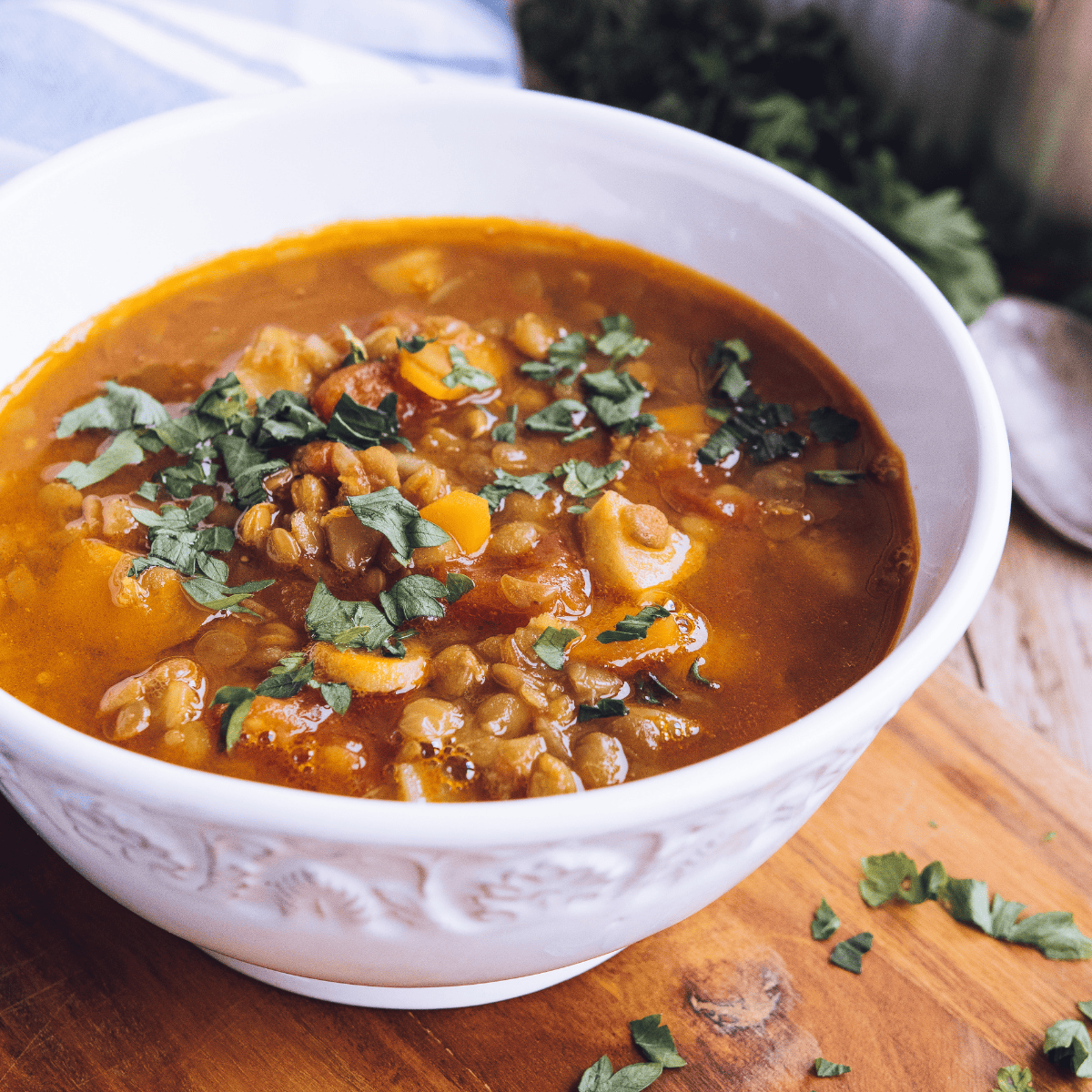
WATCH OUR LATEST VIDEO!
Table of Contents
How Much Fiber Do You Need Per Day?
According to Harvard Health, women should consume at least 21-25 grams of fiber per day, while men should shoot for 30-38 grams depending on their age.
What is Fiber?
Dietary fiber, often simply referred to as "fiber", is a type of carbohydrate found in plant foods that are not digested or absorbed in the small intestine.
Unlike other carbohydrates, which are broken down into sugars, fiber remains largely intact as it passes through the digestive system.
It's essential for promoting healthy digestion, supporting heart health, and offering a range of other benefits that make it a critical component of a balanced diet.
Types of Fiber
There are two different types of dietary fiber — soluble and insoluble. Both types are essential to consume for optimal health and they are present in our high-fiber recipes. Here is a breakdown of the differences with examples:
- Soluble fiber: Dissolves in water to form a gel-like substance. It can help lower blood cholesterol and glucose levels. Some aliments that contain soluble fiber include foods such as oats, apples, beans, lentils, peas, flax, and other seeds, nuts, and barley.
- Insoluble fiber: Does not dissolve in water. It helps to bulk up stool and promote regular bowel movements. Whole-wheat flour, wheat bran, cauliflower, and potatoes are all examples of insoluble fiber foods.
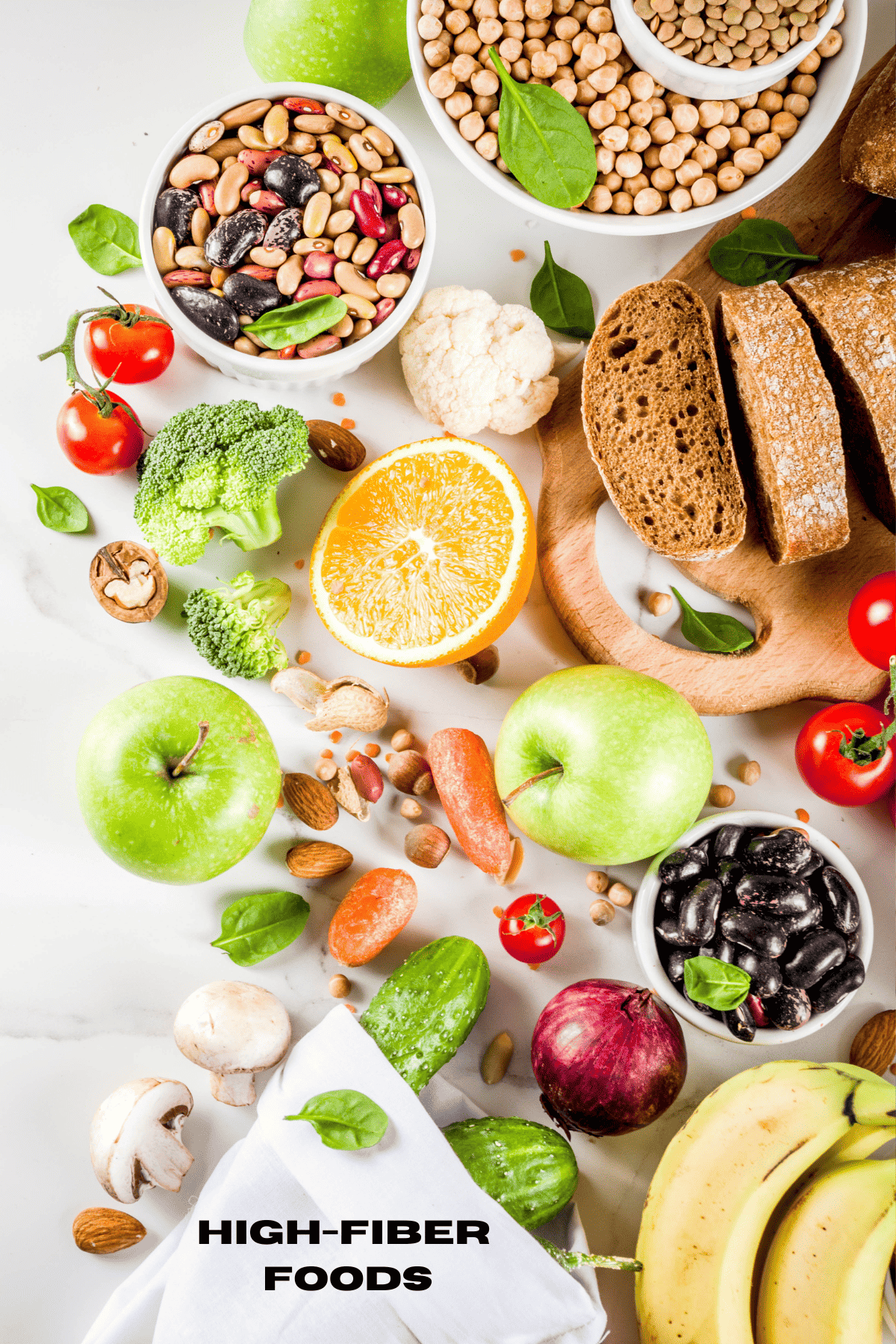
What Fiber May Be Good For
According to Mayo Clinic, consuming adequate fiber stretches beyond just digestive health. Here are some of the other body systems and functions that fiber affects:
- Digestive health: Helps in promoting regular bowel movements and preventing constipation though.
- Weight management: Fiber-rich foods can promote feelings of fullness. Thus, it leads to reduced calorie intake.
- Heart health: Fiber can help lower bad cholesterol levels. Therefore, it reduces the risk of heart disease.
- Blood sugar control: Helps stabilize blood sugar levels, which benefits diabetics or those at risk.
- Cancer prevention: Some studies suggest a high-fiber diet may reduce the risk of certain types of cancer, such as colorectal cancer.
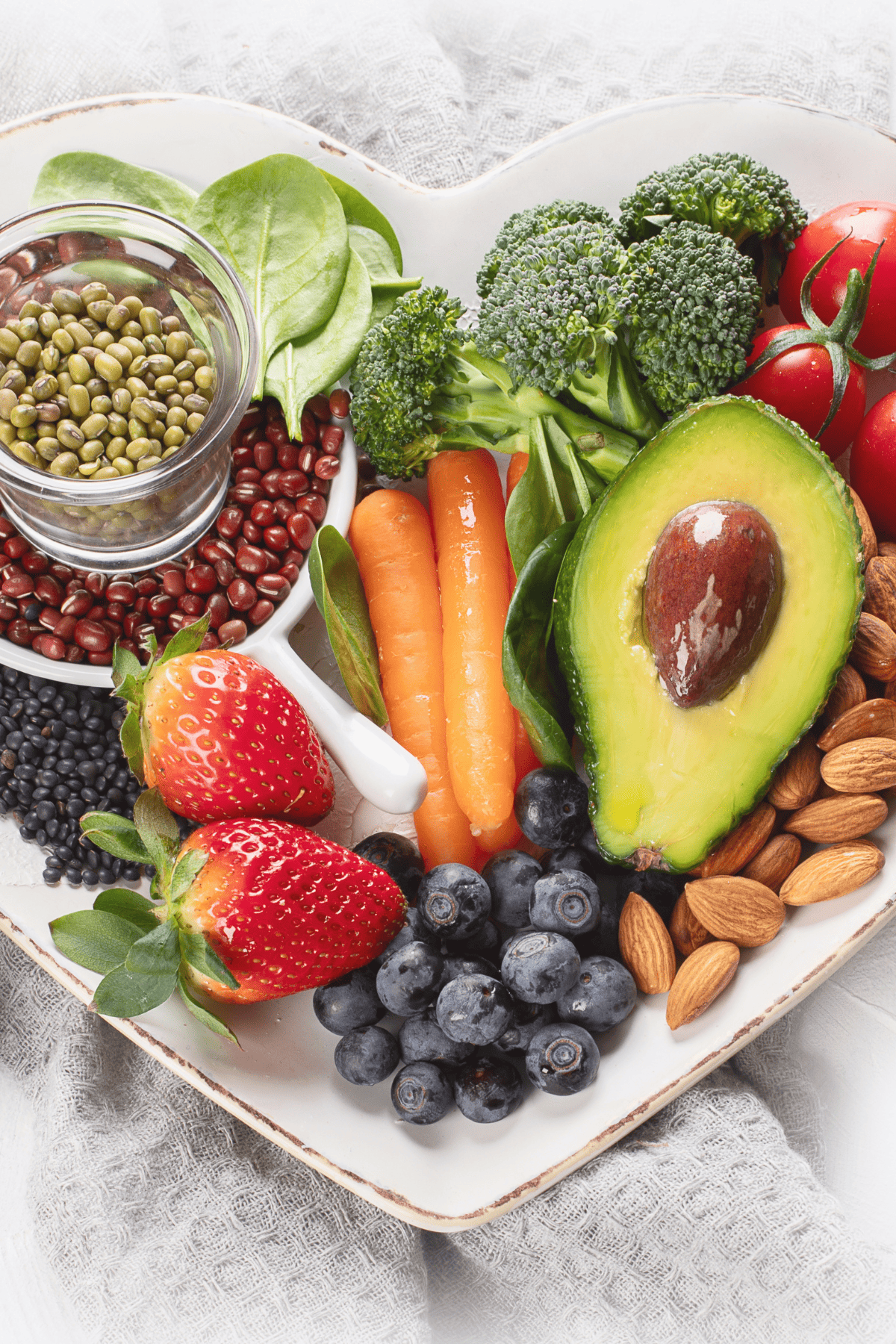
High-Fiber Foods Chart
Boost your digestive health and overall well-being with this top 50 list of high-fiber foods, ranked from the highest to the lowest fiber content. Many are present in our high-fiber meals.
SAVE THIS LIST OF HIGH-FIBER FOODS FOR CONSTIPATION!
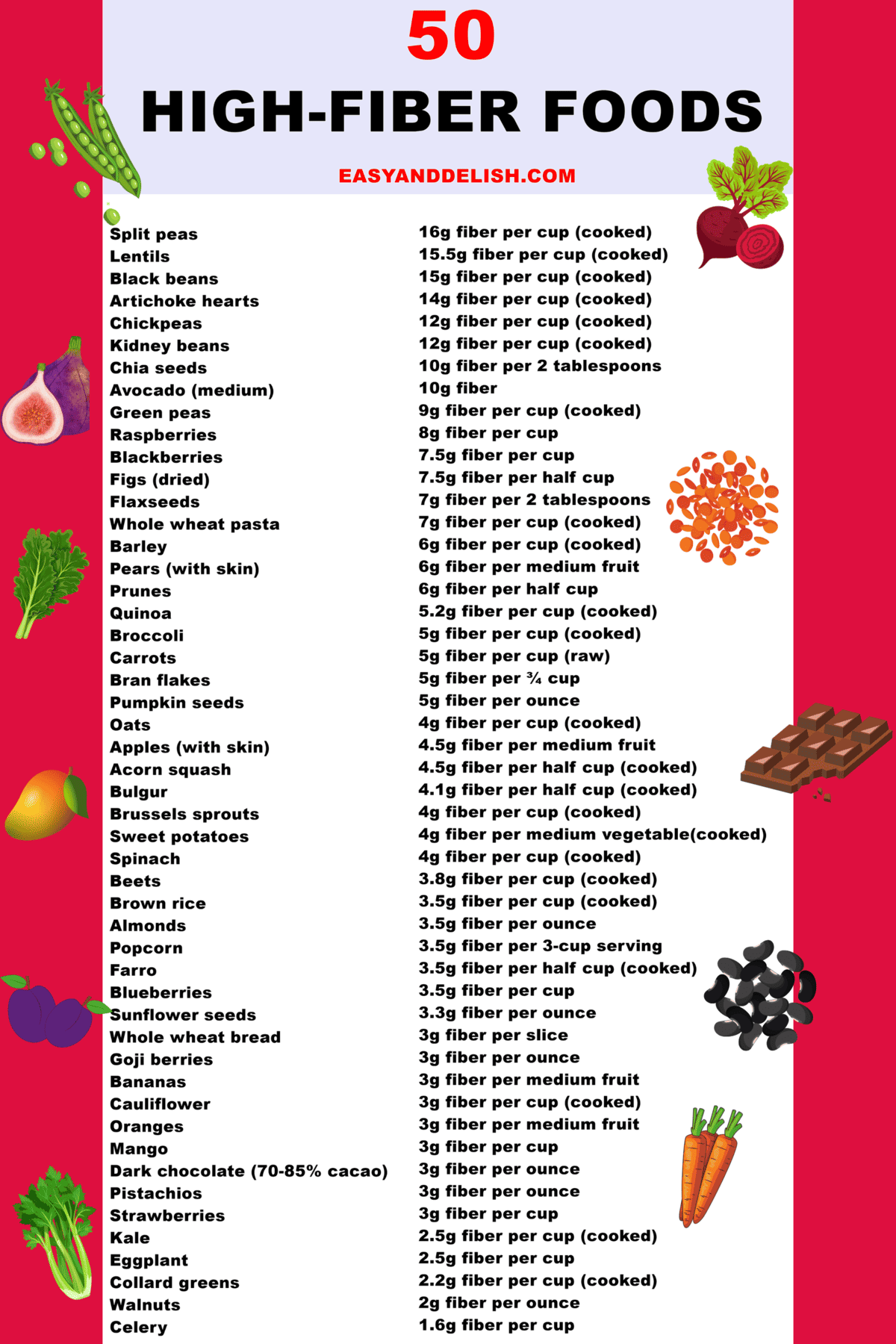
High-Fiber Low-Carb Foods List
If you are carb-conscious but also looking to add more fiber to your diet, this list of high-fiber foods is for you! Here are 35 high-fiber low-carb foods for weight loss, ranked from the highest to lowest fiber content.
Thus, save this list!
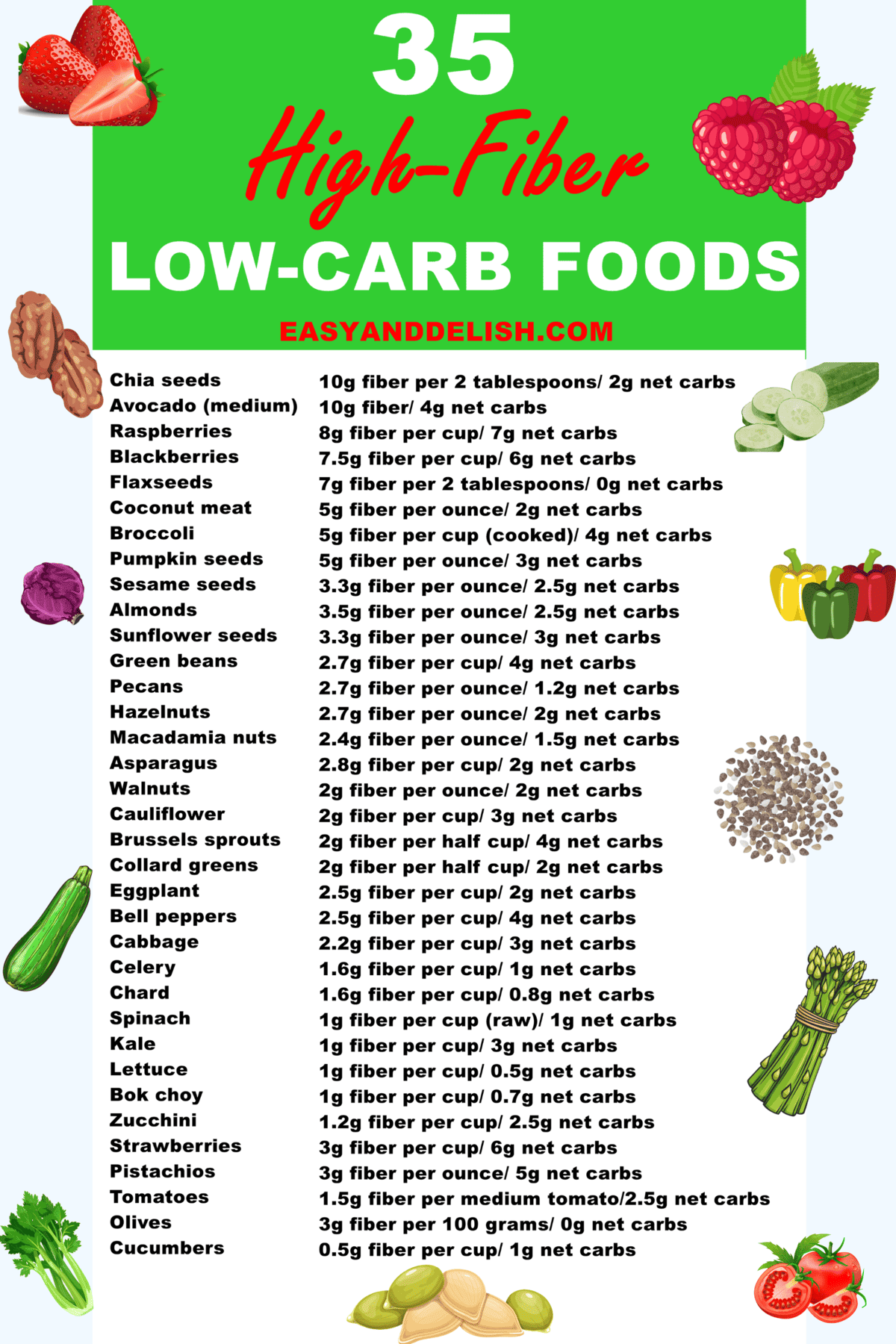
FAQs
To get about 30 grams of fiber per day, add more pulses to your main meals (i.e. split peas, lentils, and black beans) as well as chia seeds, fruits, and vegetables. One cup of cooked split peas provides 16g fiber and a cup of cooked artichoke hearts has 14 grams of fiber. Together they provide 30 g of fiber. Take a look at this high-fiber meal plan below for getting 40 g of fiber.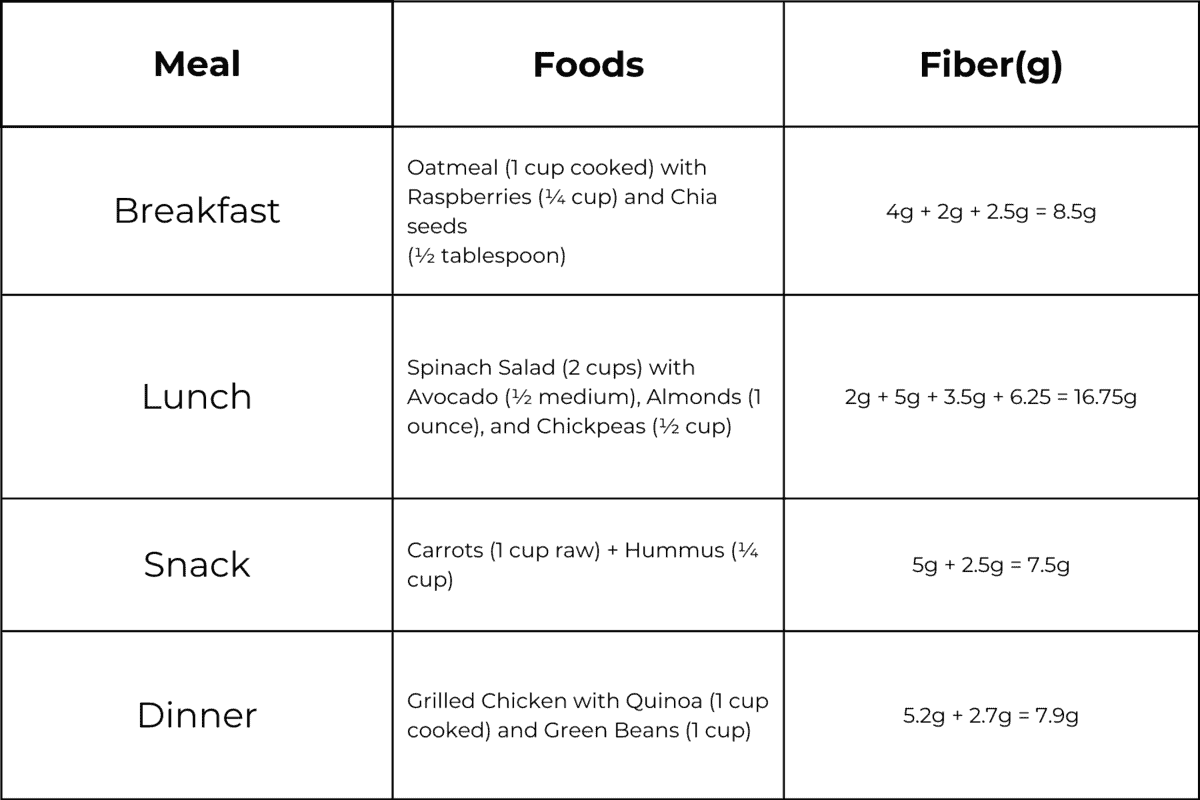
Any meal that contains 2.5-4.9 grams of fiber per serving is a good source of fiber. Thus, any that provides 5 grams or more of fiber per serving is a high-fiber meal. A bowl of lentil soup or a cup of chickpea salad can provide in one single meal nearly 15 grams of fiber which is half of the fiber a woman needs per day.
Foods that are high in insoluble fiber promote regular bowel movements, aiding with constipation. Whole-wheat flour, wheat bran, edible skin of fruits such as pears and apples, leafy greens, legumes, and cauliflower are great insoluble fiber foods.
High Fiber Meals
Enjoy our high-fiber dinners and Breakfasts. Most contain 5 grams of fiber or more per serving.
High Fiber Recipes for Breakfast
Start your day with fiber! They will fill you up and give you enough energy to go through your day. These also make great fiber-rich snacks.
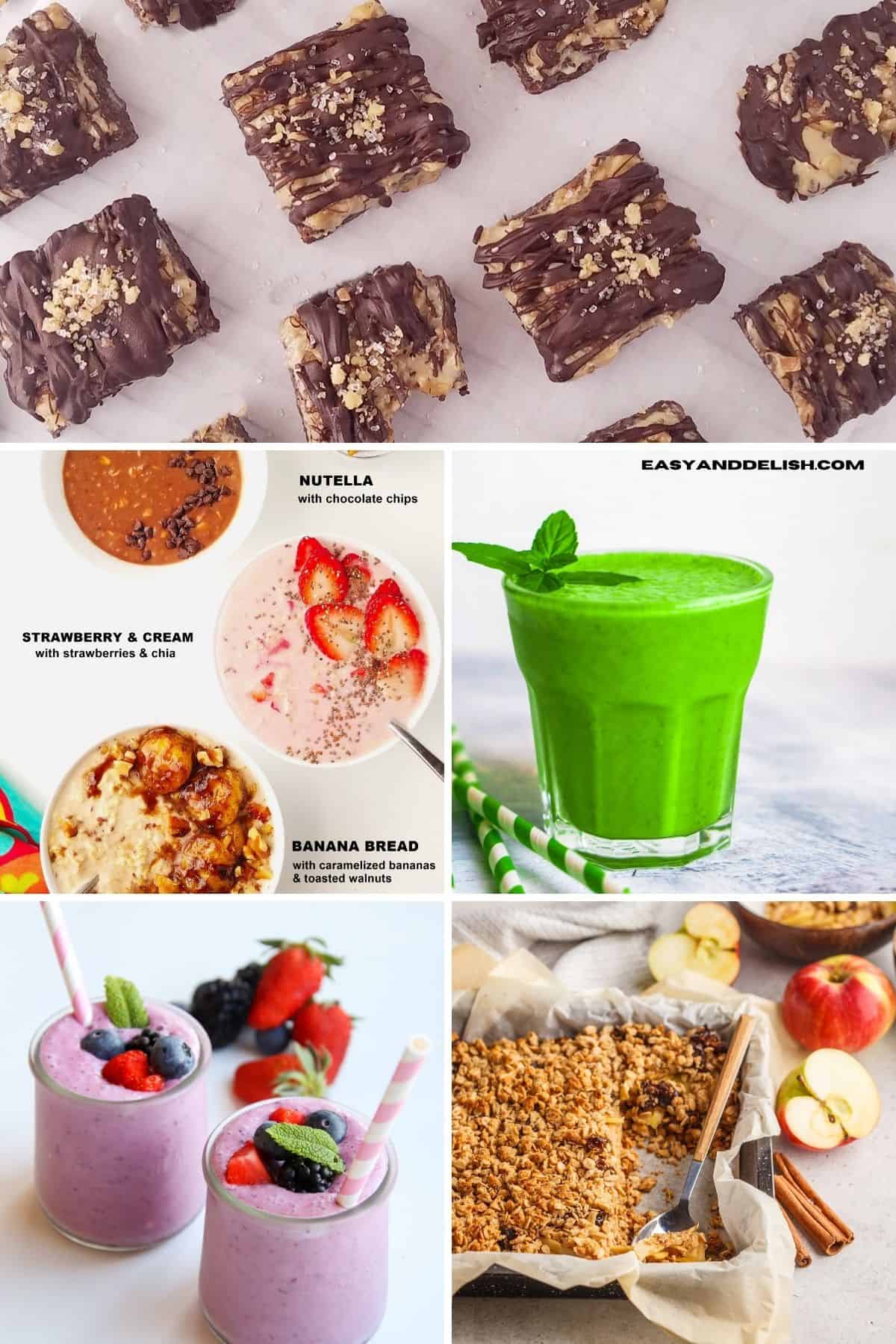
- Chocolate Chia Pudding
- Fig Bars Recipe
- Mango Chia Pudding
- Baked Oats Recipe
- Banana Chia Pudding
- No-Bake Energy Bars
- Protein Overnight Oats Recipe
- Cleansing Juice Recipes
- Apple Baked Oatmeal Recipe
- Gluten-Free Oatmeal Chocolate Chip Cookies
- Anti-Inflammatory Smoothie
- Green Smoothie Recipe
High Fiber Meals for Dinner
Enjoy these high-fiber recipes for dinner! They are rich in fiber and other nutrients and are also easy to make, most of them in up to 30 minutes. Most are complete meals while others are side dishes.

- Beef Lentil Soup
- Instant Pot Lentils
- Smashed potatoes
- Instant Pot Black Beans
- Vegetarian Feijoada
- Air Fryer Brussels Sprouts
- Cabbage Rolls
- Shaved Brussels Sprout Salad
- Butternut Squash Salad
- White Bean Salad Recipe
- Sweet Potato Soup
- Healthy Turkey Chili
- Instant Pot Brussels Sprouts
- Cucumber Chickpea Salad Recipe
- Black Beans and Rice
- Berry Salad
- Cauliflower Soup
- Mushroom Quinoa Risotto
More Healthy Recipe Round-Ups
If you love our high-fiber meals, check out also these healthy recipes below:
- 12 Gut Health Recipes
- 35 Anti-Inflammatory Recipes
- 30 Low-Carb Dinner Recipes
- 50+ Healthy Crockpot Meals for Dinner
- 50 Gluten-free Dinners
- 30 High-Protein Dinners
- 80 Low-Calorie Dinners
- 21 High-Protein Meal Preps for Lunch
PIN AND ENJOY!

30 High-Fiber Recipes for Breakfast and Dinner
Equipment
- 1 large pan or pot
- 2 medium bowls
- 1 wooden spoon
- 1 slotted spoon
- 1 cutting board
- 1 Chef's knife
Ingredients
- 2 tablespoons olive oil or avocado oil
- 1 pound boneless beef chuck cut into 1-inch cubes (for a vegan or vegetarian lentil soup recipe, skip the beef and add more veggies. Also, adjust the cooking time)
- Salt and freshly ground black pepper if not using acids such as wine and tomato paste, no need to add baking soda. Also, only add salt to your lentils after cooking them; otherwise, your lentils will become tough. Because I seasoned the beef with salt and added wine and tomato paste to the soup, I had to add baking soda.
- ½ teaspoon ground cumin
- 1 large carrot peeled and medium diced
- ½ large yellow onion chopped (or white onion)
- 3 garlic cloves chopped
- 1 cup dry red wine such as merlot or cabernet sauvignon (if needed, use a Paleo or vegan type)
- 9 cups beef broth or vegetable broth for a vegan lentil soup (the ratio of dry lentils to broth is 1:3 but we called for 9 cups of broth instead because the extra 6 cups of broth will be used to cook the beef and vegetables on the stovetop, making a lentil soup that is a little thinner. As the leftovers sit in the fridge, the lentils will absorb part of the broth)
- ½ tablespoon tomato paste
- 1 cup dry brown lentils washed and rinsed (or green lentils if you prefer) -- brown lentils are the type most commonly used in Brazil and the USA
- Pinch baking soda (about ¼ teaspoon) -- use the paleo type for a paleo recipe.
- ½ lemon
- ¼ cup fresh Italian parsley chopped
Instructions
- In a medium bowl, season the beef with salt, pepper, and cumin. Cover and let rest for about 30 minutes on the countertop.
- In a large stainless steel pot or saucepan (not an aluminum pan), heat the oil over medium-high heat. Add the beef and cook until browned ( 6-8 minutes), stirring occasionally.
- Using a slotted spoon, transfer the beef to a clean bowl. Reduce the heat to medium and add the carrots and onion to the pot, cooking until the onions are translucent about 4 minutes. Then add the garlic and cook for about 1 minute, stirring once and a while.
- Return the beef and any accumulated juices from the bowl to the pan. Add the wine, broth, and tomato paste. Stir well.
- Bring the soup to a boil; then, reduce the heat to medium-low, cover, and simmer for 30 minutes, stirring occasionally.
- Add the lentils and the baking soda, and continue simmering but uncovered until the beef and lentils are tender (usually about 35-40 minutes, although you must check for doneness after about 20-30 minutes to avoid overcooking).
- Season the lentil beef soup with salt and black pepper to taste. Remove the pot from the stove and stir in the lemon juice (to bring out all the flavors together) and parsley.
- Ladle the lentil soup into bowls and serve with hard-crusted bread and a glass of red wine. Enjoy!
Recipe Video
Recipe Notes
- RESTING TIME: 30 minutes
- INSTANT POT AND SLOW COOKER: If using different cooking methods such as making an Instant Pot lentil soup or a slow cooker lentil soup, adjust the liquid ratio to half for the Instant Pot and also the cooking time. After cooking the beef, It can take about 6-10 minutes to cook the lentils in the Instant Pot on high pressure, and 3-4 hours on HIGH or 6-8 hours on LOW in the slow cooker. Make sure to brown the beef in a separate pan and then transfer it to the crock pot to make the best lentil soup with beef.
- COOKWARE: Avoid cooking acids in aluminum cookware because the acids react with the aluminum pitting in the cooking surface of the pan and affecting the taste of the food.
- Store leftovers in an airtight container in the fridge for up to 4 days.
- Freeze them for up to 6 months.
- Reheat your lentil soup, in the microwave or in a saucepan over medium heat until hot. You may add just enough broth to the soup if it has thickened too much.
Nutrition
** Nutrition labels on easyanddelish.com are for educational purposes only. This info is provided as a courtesy and is only an estimate, since the nutrition content of recipes can vary based on ingredient brand or source, portion sizes, recipe changes/variations, and other factors. We suggest making your own calculations using your preferred calculator, based on which ingredients you use, or consulting with a registered dietitian to determine nutritional values more precisely.
Please note that health-focused and diet information provided on easyanddelish.com is for educational purposes and does not constitute medical advice, nor is it intended to diagnose, treat, cure, or prevent disease. Consult with your doctor or other qualified health professional prior to initiating any significant change in your diet or exercise regimen, or for any other issue necessitating medical advice.
This post was first published on October 4, 2023.





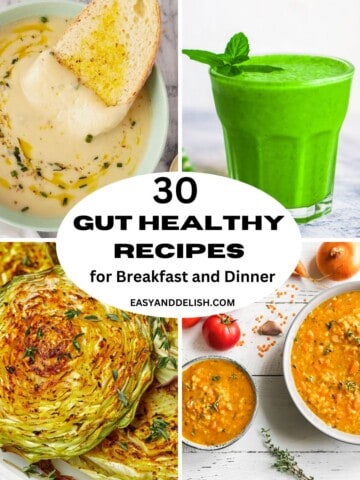



Leave a Reply